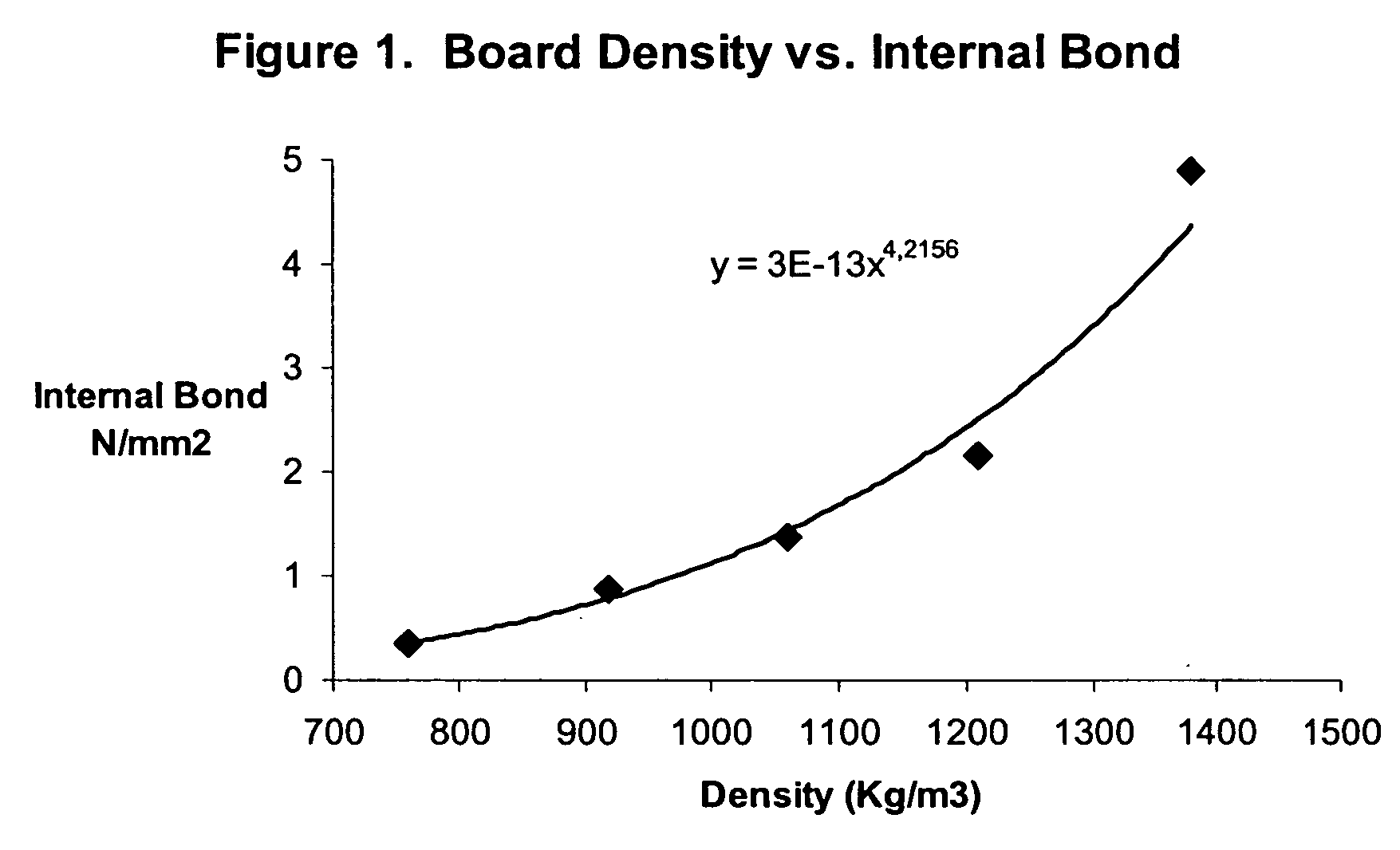Method for making dimensionally stable composite products from lignocelluloses
- Summary
- Abstract
- Description
- Claims
- Application Information
AI Technical Summary
Benefits of technology
Problems solved by technology
Method used
Image
Examples
example 2
[0037] This example demonstrates the use of higher pressing temperature and / or longer pressing time to enhance the dimensional stability, particularly the thickness swelling, of lignocellulose panel boards. Fresh maple chips containing about 57% moisture content was treated with high pressure steam (198 C.) for about 8 minutes. The treated maple chips were fed through a disc refiner under steam pressure of 6 bars to process the treated maple chips into fibers. The wet fibers were dried by hot air to a moisture content of 3-5%. The dry fibers were felted into a mat 400×400 mm. A total of 8 mats were made in an identical manner. These 8 mats were hot pressed at a platen temperature ranging from 160-220 degrees Celsius and pressed for a time ranging from 2-4 minutes. Target thickness was 8.0 mm and target density was 1,050 Kg / m3.
[0038] Test results are listed in Table 2. It is evident that mechanical properties were not significantly affected by the higher press temperature and long p...
example 3
[0039] This example illustrates the flexibility of the inventive process for making preformed semi-rigid, partially cured sheets in the thickness range of 6 to 12 mm to a density between 550 to 900 Kg / m3 for future processing into high density composite plates. The preformed sheets of fibreboard can be effectively and economically produced on a continuous press. The semi-rigid sheets are easily handled in a subsequent operation to yield a final composite product, or readily packed for shipping or storage, in contrast to the soft and fragile mats used in conventional processes.
[0040] Mixed beech and pine wood chips at a ratio of 65:35, by volume, were continuously loaded into a digester (chip cooker) at a commercial medium density fiberboard plant. The chips were cooked under a steam pressure of 12 bar (190 C.) for about 10 minutes and then extruded continuously through a pressurized refiner with counter-rotating disc plates that comminuted the steam treated wood chips into fibers a...
example 4
[0041] This example shows the densification of preformed sheets into high density composite panelboards. The preformed rigid MDF sheet, 10 mm thick, 700 kg / m3 density, containing less than 2% moisture content was, in a second operation, compressed into high density fiberboard. Two of the preformed MDF sheets were placed in a single daylight press. They were pressed under a specific pressure of 1,100 psi and a platen temperature of 165 Celsius for 25 minutes. At the end of the heating period the platen temperature was lowered to about 70 Celsius in about 3 minutes. At this time the pressure was reduced to 0 and the press was opened. The average density of this high density 10 mm fiber board was 1,370 Kg / m3. Bending strength (MOR) was 87.5 MPa, MOE: 9,740 MPa, Internal Bond: >3.5 MPa, thickness swelling after 24 hour soaking: 1-2%, and after 2 hour boiling: 4-6%, linear expansion in the length of 0.17% and linear expansion in the width of 0.16%.
PUM
| Property | Measurement | Unit |
|---|---|---|
| Electric charge | aaaaa | aaaaa |
| Electric charge | aaaaa | aaaaa |
| Electric charge | aaaaa | aaaaa |
Abstract
Description
Claims
Application Information
 Login to View More
Login to View More - R&D
- Intellectual Property
- Life Sciences
- Materials
- Tech Scout
- Unparalleled Data Quality
- Higher Quality Content
- 60% Fewer Hallucinations
Browse by: Latest US Patents, China's latest patents, Technical Efficacy Thesaurus, Application Domain, Technology Topic, Popular Technical Reports.
© 2025 PatSnap. All rights reserved.Legal|Privacy policy|Modern Slavery Act Transparency Statement|Sitemap|About US| Contact US: help@patsnap.com


